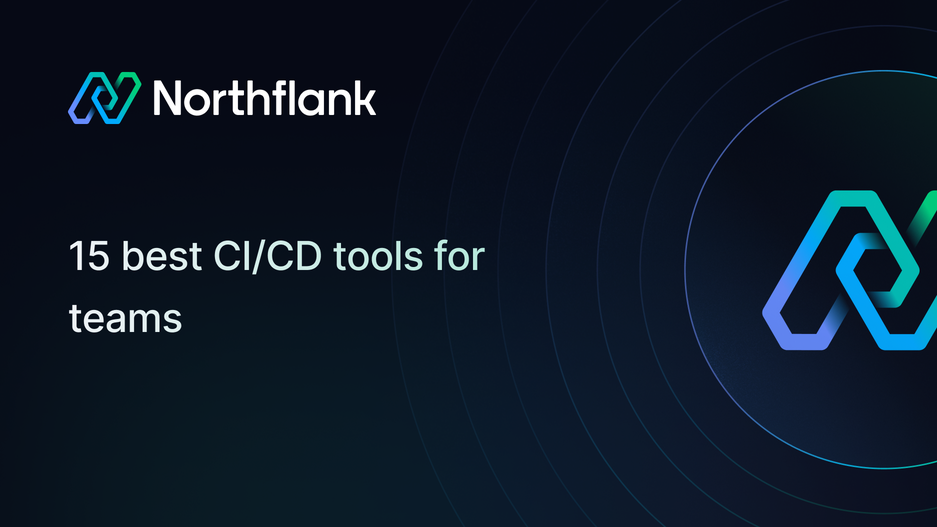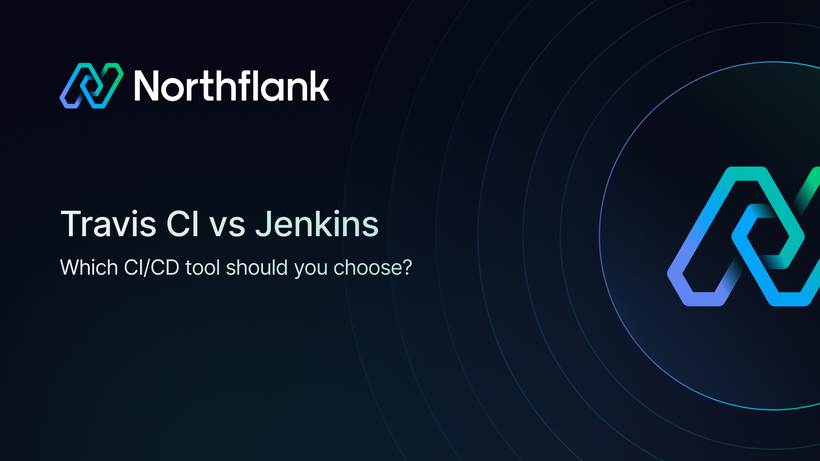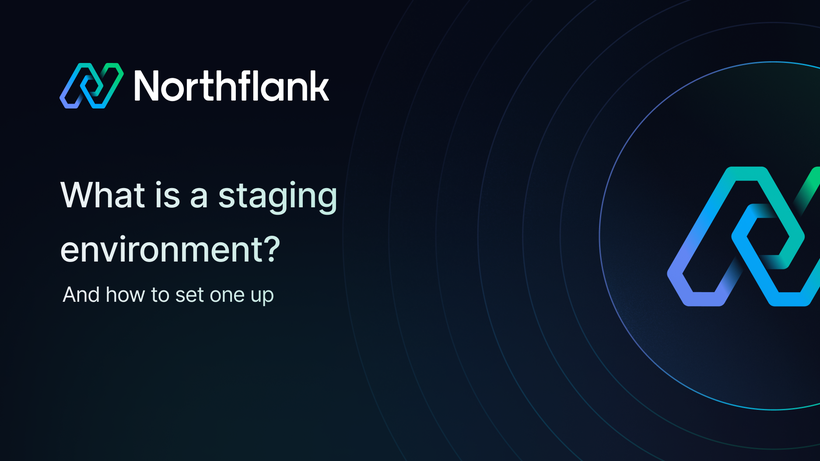

14 best CI/CD tools for teams in 2025
CI/CD tools automate your build, test, and deployment workflows to help your teams ship faster without sacrificing quality. Here are some of the top 14 options for 2025 that we’ll cover in this article:
1. Northflank
All-in-one deployment platform with built-in CI/CD, automated deployments, infrastructure management, and Kubernetes orchestration. You can deploy to any cloud with unified pipelines, preview environments, and release flows that reduce tool sprawl and context switching. Runs on Northflank's cloud or in your own AWS, GCP, Azure, Civo, Oracle, or bare-metal infrastructure with transparent, usage-based pricing and no vendor lock-in.
2. GitHub Actions
Native CI/CD for GitHub repositories with workflow automation and marketplace integrations.
3. GitLab CI/CD
DevOps platform with source control, pipelines, and deployment automation in a single interface.
4. CircleCI
Cloud-native CI/CD with parallelism, caching, and flexible execution environments.
5. Jenkins
Self-hosted automation server with a plugin ecosystem and full pipeline customization
6. Travis CI
CI/CD for open-source projects with YAML configuration and GitHub integration.
7. Azure DevOps
Microsoft's integrated toolchain covering repos, pipelines, boards, and artifacts.
8. Harness
CI/CD with automated deployment verification and rollback capabilities.
9. Bitbucket Pipelines
Built-in CI/CD for Bitbucket with tight Atlassian ecosystem integration.
10. TeamCity
JetBrains CI/CD server with Kotlin DSL for defining builds and advanced test analytics.
CI/CD stands for continuous integration and continuous delivery (or continuous deployment). It's a set of practices that automate how code moves from development to production.
Continuous integration (CI) automatically tests your code whenever developers commit changes, catching bugs early before they compound. Continuous delivery ensures your code is always ready to deploy to production, while continuous deployment takes it a step further by automatically pushing validated changes live.
Together, these practices help teams ship faster, reduce manual errors, and maintain code quality even as release frequency increases.
CI/CD tools are platforms that automate the software delivery pipeline. They connect to your version control system, automatically build your code when changes are pushed, run tests to verify everything works, and deploy your application to staging or production environments.
These tools automate the manual work of building, testing, and deploying code, turning what used to take hours or days into automated workflows that complete in minutes.
Teams use CI/CD tools to:
- Automate builds: Compile code and create deployable artifacts without manual intervention
- Run tests: Execute unit tests, integration tests, and security scans on every commit
- Manage deployments: Push code to multiple environments with consistent processes
- Orchestrate pipelines: Define complex workflows with dependencies, approvals, and parallel stages
- Monitor releases: Track deployment status, performance metrics, and error rates
- Roll back failures: Quickly revert to previous versions when issues arise
Not all CI/CD tools are built the same. See some of the key questions to ask when evaluating options for your team:
-
Do you need just CI/CD, or a complete platform?
Some tools only build and test code, while others include deployment, infrastructure management, and observability in one place.
-
Can it integrate with your existing stack?
Check compatibility with your version control system (GitHub, GitLab, Bitbucket), cloud providers, container registries, and monitoring tools.
-
Self-hosted or cloud-managed?
Self-hosted options give you more control but require ongoing maintenance, while cloud-managed services handle updates and scaling for you.
-
How complex are your deployment workflows?
Simple pipelines work with basic tools, but multi-environment deployments, canary releases, and approval gates need more sophisticated features.
-
What's your budget and pricing model?
Tools charge by build minutes, users, compute resources, or flat monthly fees, so, understand your usage patterns and watch for hidden costs.
-
Do you have DevOps expertise in-house?
Some tools require significant setup and maintenance, while others provide guided configuration and managed infrastructure.
-
What security and compliance requirements do you have?
Look for features like secrets management, RBAC, audit logs, and support for air-gapped or private cloud deployments.
These 14 CI/CD tools represent the best options for different team sizes, tech stacks, and deployment strategies in 2025.
Northflank combines CI/CD with deployment infrastructure in a single platform. Instead of connecting multiple tools, such as a CI service, a deployment platform, and an observability stack, Northflank handles the full lifecycle from code to production.
Builds trigger automatically from GitHub, GitLab, or Bitbucket commits (See how). You can configure path rules to build only when specific directories change, or skip builds based on commit messages (See how). Continuous deployment keeps your environments up to date with the latest validated builds.
Where Northflank differs from standalone CI/CD tools is what happens after the build.
You get full-stack preview environments, including databases and microservices, triggered by pull requests, release flows with approval gates and rollback capabilities, and pipelines that orchestrate deployments across staging and production.
Everything runs on Kubernetes, either on Northflank's cloud or self-hosted in your own GCP, AWS, Azure, Civo, Oracle, or bare-metal infrastructure, without exposing you to YAML complexity.
Built-in secrets management, RBAC, and audit logs address security requirements, while the BYOC (Bring Your Own Cloud) option ensures you maintain full control over data residency and compliance.

Key features:
- Unified platform for CI/CD, deployment, and infrastructure management
- Full-stack preview environments, including databases and microservices
- Release flows with approval gates and rollback capabilities
- Deploy to Northflank's cloud or bring your own cloud (BYOC) (in your own AWS, GCP, Azure, Civo, Oracle,or bare-metal infrastructure)
- Built-in observability and secrets management
- GPU support for AI workloads
- Path rules and commit message filters (See how)
- Usage-based pricing (pay for compute, not per seat)
Best for: Teams wanting CI/CD integrated with deployment infrastructure. Organizations running Kubernetes without operational overhead. Companies needing multi-cloud or Bring Your Own Cloud (BYOC) deployments. Teams deploying AI/ML workloads with GPU requirements alongside standard applications.
Learn more:
- How to manage CI/CD on Northflank
- See how Weights scales to millions of users without a DevOps team
- How Clock manages 30,000 deployments with 100% uptime
Start with Northflank's free sandbox to test your first deployment, or book a demo with our engineering team to discuss how Northflank fits your organization's specific needs.
GitHub Actions provides CI/CD directly within GitHub repositories. Workflows are defined in YAML files and trigger automatically on push, pull request, or scheduled events, with access to a marketplace of pre-built actions for common tasks.

Key features:
- Native GitHub integration with no external setup
- Matrix builds to test across multiple environments
- Self-hosted runners for custom infrastructure
- Free tier for open source
Best for: Teams with code hosted on GitHub who want integrated CI/CD.
Read more: GitHub Actions vs Jenkins, CircleCI vs GitHub Actions
Worth noting: GitHub Actions handles CI/CD but doesn't include deployment infrastructure, preview environments, or release orchestration. Teams typically pair it with platforms like Northflank for managing multi-environment deployments and rollbacks.
GitLab CI/CD is part of GitLab's DevOps platform, which includes version control, issue tracking, code review, and deployment in one interface. Pipelines are defined in .gitlab-ci.yml files and executed by GitLab Runners on your infrastructure or GitLab's shared runners.

Key features:
- Integrated platform for code, CI/CD, and deployment
- Self-hosted and cloud options
- Built-in container registry and Kubernetes integration
- Security scanning and compliance features
Best for: Teams who want an integrated platform, or organizations with specific data residency requirements.
Read more: Best GitLab alternatives
Things to consider: GitLab provides an integrated platform, but teams wanting Bring Your Own Cloud (BYOC) flexibility or multi-VCS support (GitHub, GitLab, Bitbucket) often look at alternatives like Northflank that work across version control systems.
CircleCI is a cloud-native CI/CD platform where builds run in Docker containers or VMs. Configuration lives in .circleci/config.yml files, and CircleCI Orbs provide reusable configuration packages for common workflows.

Key features:
- Caching and parallelism for faster builds
- SSH access to running builds for debugging
- Flexible compute options (Docker, VM, ARM)
- Usage-based pricing
Best for: Teams prioritizing build speed.
Read more: CircleCI vs Jenkins, CircleCI vs GitHub Actions, Top CircleCI alternatives, Travis CI vs CircleCI
Things to consider: CircleCI does well at CI/CD but doesn't handle post-build deployment, infrastructure, or environment orchestration. Teams often pair it with deployment platforms like Northflank to manage the full delivery pipeline.
Jenkins is a self-hosted, open-source CI/CD platform. Pipelines are defined in Jenkinsfiles using Groovy syntax, and with over 1,800 plugins, Jenkins integrates with many tools in your stack.

Key features:
- Plugin ecosystem with 1,800+ plugins
- Distributed builds with master-agent architecture
- Customization and control
- Free and open source
Best for: Organizations with DevOps expertise who need control over CI/CD infrastructure.
Read more: Jenkins alternatives, CircleCI vs Jenkins, GitHub Actions vs Jenkins
Worth noting: Jenkins offers complete control but requires dedicated DevOps resources for maintenance, plugin management, and security updates. Platforms like Northflank provide similar flexibility with Kubernetes without the operational overhead.
Travis CI provides CI/CD with GitHub integration. Add a .travis.yml file to your repository, enable the repo in Travis, and builds start automatically on commits.

Key features:
- YAML configuration
- Multi-language and multi-OS builds
- GitHub and Bitbucket integration
Best for: Small teams needing straightforward CI.
Read more: Top Travis CI alternatives, Travis CI vs CircleCI
Worth noting: Travis CI focuses primarily on continuous integration. Teams needing continuous deployment, infrastructure management, or Kubernetes orchestration typically supplement it with platforms like Northflank.
Azure DevOps is Microsoft's DevOps solution that includes Azure Repos (Git repositories), Azure Pipelines (CI/CD), Azure Boards (project tracking), Azure Artifacts (package management), and Azure Test Plans. Azure Pipelines supports any language, platform, and cloud.

Key features:
- DevOps toolchain with repos, pipelines, boards, and artifacts
- Cross-platform and multi-cloud support
- Built-in package management
- Enterprise security features
Best for: Organizations using Microsoft technologies or needing an integrated DevOps suite.
Read more: Top Azure DevOps alternatives
Harness is a CI/CD platform that uses machine learning to verify deployments, detect anomalies, and recommend optimizations. The platform supports deployment strategies like canary deployments and blue-green rollouts with automated verification and rollback.

Key features:
- Automated deployment verification
- Machine learning-based pipeline optimization
- Canary and blue-green deployment strategies
- Cloud cost management capabilities
Best for: Organizations needing deployment automation with verification and rollback capabilities.
Read more: Top alternatives to Harness
Things to consider: Harness offers advanced features but can become expensive as usage scales. Teams evaluating cost-effective alternatives often compare it with platforms like Northflank that offer usage-based pricing without per-seat charges.
Bitbucket Pipelines provides CI/CD directly within Bitbucket Cloud. Configuration uses YAML files stored in your repository, and Bitbucket Pipes provide reusable components for common tasks.

Key features:
- Built into Bitbucket Cloud
- Docker-native execution
- Atlassian ecosystem integration
- Predictable pricing
Best for: Teams using Bitbucket and Atlassian products.
TeamCity is JetBrains' CI/CD server that supports defining builds through the web interface or with Kotlin DSL. The platform includes test analytics with flaky test detection and build chains for defining dependencies between projects.

Key features:
- Kotlin DSL for pipeline definitions
- Test reporting with flaky test detection
- Build chain dependencies
- Web interface and CLI options
Best for: Teams wanting CI/CD with Kotlin DSL configuration.
Argo CD is a GitOps continuous delivery tool for Kubernetes. It continuously monitors your Git repository and ensures your Kubernetes cluster matches the desired state defined in Git, making Git the single source of truth for your infrastructure.

Key features:
- GitOps-based deployment model
- Automatic sync from Git to Kubernetes
- Multi-cluster support
- Drift detection and remediation
Best for: Teams running Kubernetes who want Git-driven deployments.
Read more: Argo CD alternatives
Spinnaker is a multi-cloud continuous delivery platform originally built at Netflix. It supports deployment strategies like canary analysis, blue-green deployments, and multi-region rollouts with automated verification at each stage.

Key features:
- Multi-cloud deployment support
- Canary, blue-green, and multi-region deployment strategies
- Pipeline templates and reusability
- Integration with monitoring tools for verification
Best for: Organizations deploying across multiple clouds with complex release requirements.
Read more: Best Spinnaker alternatives
AWS CodePipeline is Amazon's managed CI/CD service that orchestrates build, test, and deployment stages using AWS tools like CodeBuild, CodeDeploy, and Lambda. It integrates with AWS's IAM security model and CloudFormation.

Key features:
- Native AWS integration
- Managed service with no servers to maintain
- Pay-per-pipeline pricing
- Visual pipeline builder
Best for: Teams using AWS infrastructure.
Google Cloud Build is GCP's managed CI/CD service that builds container images and integrates with GKE (Google Kubernetes Engine), Cloud Run, and other GCP services. Build configurations use YAML or Dockerfile.

Key features:
- Container builds
- Native GCP integration
- Built-in vulnerability scanning
- Free tier included
Best for: Teams deploying to Google Cloud Platform.
Northflank combines CI/CD with deployment infrastructure in one platform. Builds trigger from GitHub, GitLab, or Bitbucket, and full-stack preview environments, including databases and microservices, spin up automatically from pull requests for fast testing and feedback.
What you get:
- Release flows with approval gates and rollbacks
- Kubernetes deployments on Northflank's cloud or your own infrastructure (AWS, GCP, Azure, Civo, Oracle, bare-metal) without YAML complexity
- Built-in observability, secrets management, and RBAC
- GPU support for AI workloads
- Usage-based pricing that charges for compute resources, not per seat
- A unified platform that takes out the need to combine separate tools
Start with Northflank's free sandbox to test your first deployment, or book a demo with our engineering team to discuss how Northflank fits your organization's specific needs.


